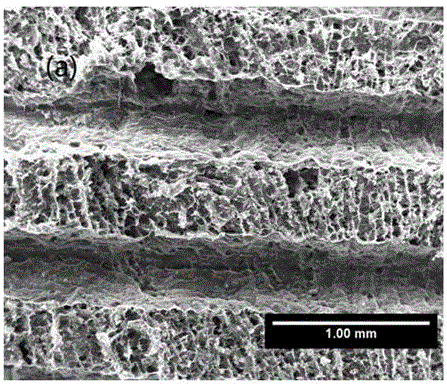Method for preparing hydroxyapatite crystal whisker porous ceramic support material
A technology of hydroxyapatite and porous ceramics, applied in the field of biomedical materials, can solve the problems of low mechanical strength, limited application range, poor bonding between slurry and organic foam, etc.
- Summary
- Abstract
- Description
- Claims
- Application Information
AI Technical Summary
Problems solved by technology
Method used
Image
Examples
Embodiment 1
[0026] A method for preparing a hydroxyapatite whisker porous ceramic support material, the specific operations are as follows:
[0027] (1) Place a beaker with 1L of distilled water on a magnetic stirrer for stirring, add 80ml of silica gel, 24g of potassium laurate, 8g of cellulose, and 6g of sodium stearate in sequence, and stir thoroughly to completely dissolve the raw materials and produce a large amount of Then gradually add 160g HAP whiskers in 10 times, and finally add 10gKGM, stir well, so that the slurry can reach the condition that can be extruded;
[0028] (2) Use a mold to extrude the slurry into sample A with a regular porous structure, pay attention to the shape of the molded sample and the integrity of the pores.
[0029] (3) Put sample A in a -80°C refrigerator for 12 hours, take the frozen sample out of the refrigerator, and dry it in a freeze dryer (at a temperature of -30°C and a pressure of 20Pa) for 12 hours. After drying, put Cut the sample into a regul...
Embodiment 2
[0034] A method for preparing a hydroxyapatite whisker porous ceramic support material, the specific operations are as follows:
[0035] (1) Place a beaker with 1L of distilled water on a magnetic stirrer for stirring, add 80ml of silica gel, 30g of potassium laurate, 10g of cellulose, and 7g of sodium stearate in sequence, and stir thoroughly to completely dissolve the raw materials and produce a large amount of Then gradually add 300g HAP whiskers in 10 times, and finally add 14gKGM, stir well, so that the slurry can reach the condition that can be extruded;
[0036] (2) Use a mold to extrude the slurry into sample A with a regular porous structure, pay attention to the shape of the molded sample and the integrity of the pores.
[0037] (3) Put sample A into -60℃ refrigerator to freeze for 6 hours, take out the frozen sample from the refrigerator, and dry it in a freeze dryer (at a temperature of -35℃ and a pressure of 25Pa) for 14 hours. After drying, put Cut the sample in...
Embodiment 3
[0042] A method for preparing a hydroxyapatite whisker porous ceramic support material, the specific operations are as follows:
[0043] (1) Place a beaker with 1L of distilled water on a magnetic stirrer for stirring, add 80ml of silica gel, 48g of potassium laurate, 16g of cellulose, and 8g of sodium stearate in sequence, and stir thoroughly to completely dissolve the raw materials and produce a large amount of Then gradually add 240g HAP whiskers in 15 times, and finally add 12gKGM, stir well, so that the slurry can reach the condition that can be extruded;
[0044] (2) Use a mold to extrude the slurry into sample A with a regular porous structure, pay attention to the shape of the molded sample and the integrity of the pores.
[0045] (3) Put sample A in a refrigerator at -50°C for 24 hours, take the frozen sample out of the refrigerator, and dry it in a freeze dryer (at a temperature of -40°C and a pressure of 30 Pa) for 18 hours. After drying, put Cut the sample into a ...
PUM
| Property | Measurement | Unit |
|---|---|---|
| pore size | aaaaa | aaaaa |
| thickness | aaaaa | aaaaa |
| thickness | aaaaa | aaaaa |
Abstract
Description
Claims
Application Information
 Login to View More
Login to View More - R&D
- Intellectual Property
- Life Sciences
- Materials
- Tech Scout
- Unparalleled Data Quality
- Higher Quality Content
- 60% Fewer Hallucinations
Browse by: Latest US Patents, China's latest patents, Technical Efficacy Thesaurus, Application Domain, Technology Topic, Popular Technical Reports.
© 2025 PatSnap. All rights reserved.Legal|Privacy policy|Modern Slavery Act Transparency Statement|Sitemap|About US| Contact US: help@patsnap.com



